 FlashOver3D™
FlashOver3D™
How to Watch 3D
The computational requirements for 3D video are orders of magnitude greater than those for 2D. It takes a big bag of tricks to coax 3D out of today's hard- and software… Until more powerful devices enter the marketplace and HTML5 web standards become as ubiquitous as promised, follow the hints in this guide for best results.
3D Player Functions
3D players and viewers have many more options than their 2D
counterparts. Users appreciate the time to look them over, so we
don't hide any user interface elements automatically. To
show and hide the entire UI, click or touch anywhere on the
player. The 

 buttons have a similar toggle function.
Nothing happens unless you explicitly click or touch an item.
More →
buttons have a similar toggle function.
Nothing happens unless you explicitly click or touch an item.
More →
 toggle resolutions
toggle resolutions
 toggle 3D displays
toggle 3D displays
 swap stereo views
swap stereo views
 toggle volume slider
toggle volume slider
 enlarge to browser
enlarge to browser
 enlarge to screen
enlarge to screen
3D Display Modes
 cross-eyed viewing
cross-eyed viewing
 2D view, left eye
2D view, left eye
 KMQ under-over
KMQ under-over
 Holoblade over-under
Holoblade over-under
 right eye mirrored
right eye mirrored
 red-cyan anaglyph
red-cyan anaglyph
 yellow-blue anaglyph
yellow-blue anaglyph
 green-magenta
green-magenta
 line interlaced
line interlaced
 column interlaced
column interlaced
 checkerboard
checkerboard
 3DTV side-by-side
3DTV side-by-side
 NVIDIA 3D Vision
NVIDIA 3D Vision
Supported 3D Hardware
3D With a Desktop or Laptop Computer
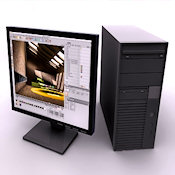
Our HTML5 players and viewers have been tested thoroughly with current versions of Google Chrome, Mozilla Firefox, Internet Explorer, Opera, and Safari. For watching 3D with our players, we can recommend (in this order) Mozilla Firefox, Google Chrome, and Opera. Combined they make up the largest number of web browsers in use today. More →
Occasionally, Google Chrome may render fullscreen 3D
displays sluggishly, which means GPU hardware acceleration is
likely disabled. To find out, enter
chrome://flags/#gpu in the browser. Type
chrome://flags/#ignore-gpu-blacklist to fix the
problem. Click Enable to override Chrome's built-in software
rendering list and permit GPU acceleration on unsupported
configurations. Especially if you're running experimental GPU
drivers, enabling this flag will probably shorten load times for
games and videos, too. Don't forget to relaunch the browser for the
change to take effect.
Internet Explorer must be at least version 9, as the older IE versions are simply not standards-compliant. Expect sluggish performance with anaglyph (“funny glasses”) displays processed in real-time. Pre-boosted anaglyph video and all other 3D modes are no problem. Fullscreen display can be reached by pressing the F-11 key and clicking the fullscreen icon in the player.
Apple Safari performs somewhat satisfactorily only at the lowest resolutions, because it still lacks an animation timer. Safari for Windows also squanders resources by drawing video from an external QuickTime installation, which sadly, is a prerequisite for playing video in Safari at all. Most annoying, it isn't possible to seek to a video portion which hasn't been downloaded yet. Changing resolutions is therefore a bit of a hassle. Owing to the poor implementation of HTML5 in Safari, there are other quirks, too. We can't recommend Safari except for a 3D sneak peek. Mac users should prefer Google Chrome over Safari.
3D With a Tablet or SmartPhone

On devices with Android 4.1 or greater, our HTML5 players will perform best in the Google Chrome browser, provided the device has a modicum of processing power and a fast network connection. Mozilla Firefox also gives good results, albeit at lower resolutions. These two browsers account for the lion's share of the Android browser app market. More →
Among others, we tested the FlashOver3D.com website on an Asus Memo Pad HD7, a low-cost, low-end tablet running the Android 4.2.2 OS. Both in Google Chrome and Mozilla Firefox, we had enjoyable 3D viewing experiences. Even a Samsung Galaxy S3 Mini smartphone (Android 4.1.2) does 3D quite well, although the display is a bit small for 3D.
Please note, browser apps opening in-line videos in a fullscreen player by default (e.g. Opera) are not 3D-capable, as they are showing the unprocessed stereoscopic source rather than the viewable 3D video. Browsers relying on the Android WebView (Android system browser and “Me Too” browsers like Puffin or Dolphin) will work only in a very limited fashion and with some quirks. The Android WebView doesn't give access to video bitmap data for real-time processing, which is a requirement for 3D. At this time, we can only recommend the Google Chrome and Mozilla Firefox browser apps.
iPad and iPhone: A Poor Showing
The biggest disappointment are Apple iOS devices: Considering how vocally the good folks in Cupertino demonized the evil, proprietary ways of Adobe's Flash (which can do 3D quite easily), they should have hands-down the best and most current implementation of HTML5 standards around. Not so! As of now, it is still not possible to process 3D in real-time on any iOS device.
Just like on the desktop, the iOS browser apps lack key ingredients long since standardized and implemented by Apple's competition. Conclusion: Apple needs to spend a little more time on product improvements, and a little less effort on frivolous patent lawsuits against companies whose products are actually getting better with every development cycle. Better luck with iOS 8 perhaps…
3D With a 3DTV

For the time being, you will likely need to connect your 3DTV to your computer. The 3DTV should be configured
as an un-mirrored extension of your desktop. Launch your browser
and drag the browser window onto the 3DTV or extended desktop. In
the FlashOver3D™ player, click the  icon, and click
icon, and click  to select 3DTV display. Click
to select 3DTV display. Click  to turn on the player's fullscreen mode. Use
the 3DTV remote to select the side-by-side input layout.
More →
to turn on the player's fullscreen mode. Use
the 3DTV remote to select the side-by-side input layout.
More →
We understand, some of the newer SmartTVs are equipped with Android. In theory, those 3DTVs should be able to run our 3D players like mobile devices, provided the on-board web browser could be substituted with the Google Chrome browser app. So far, we have not been able to test this theory. Please contact us if you own an Android SmartTV and have managed to get our players to run. Thanks, we really appreciate the help!
Using a Polarized Monitor or 3D Notebook

Our 3D players are easily adjusted to stereoscopic displays
requiring interlaced imagery. For line-interlaced devices like the
LG, Zalman, and Hyundai 3D monitors, or for Acer Aspire 3D
notebooks, click on  in the 3D player or viewer. Then click on
the
in the 3D player or viewer. Then click on
the  icon to change the display mode. Click
icon to change the display mode. Click  to swap sides if needed. To set the player
to a column-interlaced display, click on
to swap sides if needed. To set the player
to a column-interlaced display, click on  and select the
and select the  icon. Clicking the
icon. Clicking the  icon will result in a checkerboard display.
More →
icon will result in a checkerboard display.
More →
For 3D notebooks (or computers) which use NVIDIA 3D Vision shutter
glasses instead of polarization, our 3D players provide a special
display mode. The original, un-processed video stream is sent
directly to the display. At the same time, the NVIDIA browser
plugin is embedded in the web page with the 3D player. To activate
NVIDIA mode, click  in the player and select the
in the player and select the  icon.
icon.
Please note, the correct functioning of NVIDIA 3D Vision is subject to many requirements. Your machine needs the right hardware, operating system, drivers, and plugin. The participating website must follow video encoding guidelines to show video in 3D Vision. Quite frankly, for many webmasters (us included), the NVIDIA flicker fest is more hassle than it's worth, so don't expect too much from this display mode.
Viewing 3D With Anaglyph Glasses
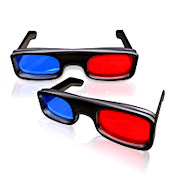
100 years young and still going strong: the anaglyph 3D system
works on any color monitor or screen. All you need is a pair of
“funny glasses”. Chances are, you have some red-cyan
ones around the house. In the 3D player, click  and select the
and select the  icon. To use yellow-blue glasses, click the
icon. To use yellow-blue glasses, click the
 icon instead. This mode is compatible with
ColorCode 3-D™. Set the player to green-magenta by clicking
the
icon instead. This mode is compatible with
ColorCode 3-D™. Set the player to green-magenta by clicking
the  icon for use with TrioScopics™
glasses. Default: left eye = red = yellow = green. Swap sides
icon for use with TrioScopics™
glasses. Default: left eye = red = yellow = green. Swap sides  if needed.
if needed.
3D With Parallel Prism Viewers
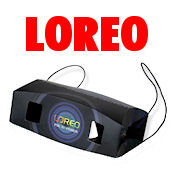
Parallel prism viewers make it easy to enjoy full-color 3D from 2D
screens. For larger computer monitors and greater viewing
distances, the Loreo Pixie Viewer might be just the ticket.
With tablet screens, the Loreo Lite 3D Viewer delivers an almost
cinematic 3D experience. Both viewers are lightweight, foldable,
and dirt cheap. A stereo card lorgnette also works well on small
screens. In the 3D player, click on  and
and  for a side-by-side display. Then click the
for a side-by-side display. Then click the
 icon to change from cross-eyed to parallel
viewing.
icon to change from cross-eyed to parallel
viewing.
3D With a KMQ Prism Viewer
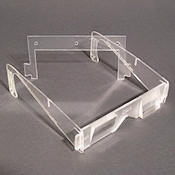
In the 1980s, as an alternative to cross-eyed viewing, the
physicists Christoph Koschnitzke, Reiner Mehnert, and Peter Quick
invented a new type of prismatic viewer that tilts the right eye
view slightly up and the left eye view slightly down. To adjust our
3D player for use with the KMQ
viewer, click on the  icon and select the
icon and select the  mode. By default, the view for the right eye
is the top image on screen. For best results, click
mode. By default, the view for the right eye
is the top image on screen. For best results, click  to enlarge the player to full screen size.
to enlarge the player to full screen size.
3D With a Holoblade Viewer
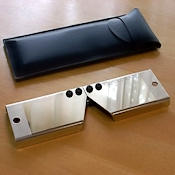
If you happen to own one of those clever Japanese first-surface mirror gizmos, you can watch full
color 3D on any regular screen. On our 3D player or viewer, click
 and select the
and select the  icon. Then hold the Holoblade below your
eyes and slightly tilt your head down. Adjust the mirrors until the
images fuse into the 3D view. With the Holoblade viewer, the view
for the left eye is on top.
icon. Then hold the Holoblade below your
eyes and slightly tilt your head down. Adjust the mirrors until the
images fuse into the 3D view. With the Holoblade viewer, the view
for the left eye is on top.
3D With a Household Mirror

For a sneak peek at 3D, you can experiment with a household or
pocket mirror. Click  and select the
and select the  icon on the 3D player. Place the mirror over
the bridge of your nose, perpendicular to your face and the screen,
with the mirror surface on the right. The left eye looks directly
at the normal image. Adjust the mirror to catch the image on the
right and stop when the two pictures superimpose and fuse. Be
patient, it takes some fiddling and some practice, but it's a fun
experiment.
icon on the 3D player. Place the mirror over
the bridge of your nose, perpendicular to your face and the screen,
with the mirror surface on the right. The left eye looks directly
at the normal image. Adjust the mirror to catch the image on the
right and stop when the two pictures superimpose and fuse. Be
patient, it takes some fiddling and some practice, but it's a fun
experiment.
Cross-Eyed and Parallel 3D Freeviewing

With a little practice, you can see 3D without any viewer.
Cross-eyed viewing is usually easier to master and suitable for
larger images and screens. On the 3D player, click  and select the
and select the  icon to activate a cross-eyed display with
the right eye view on the left of the screen. (Click the
icon to activate a cross-eyed display with
the right eye view on the left of the screen. (Click the  icon if you prefer a parallel display.) You
can best learn the cross-eyed and parallel freeviewing techniques
from The Optometrists Network.
icon if you prefer a parallel display.) You
can best learn the cross-eyed and parallel freeviewing techniques
from The Optometrists Network.
Photos courtesy of FreeDigitalPhotos.net, Idea Go, Naypong, Michal Marcol, Boians Cho Joo Young, Loreo Asia Ltd., Thomas Kumlehn, HitDesign Ltd., Emery, and WikiMedia Commons.